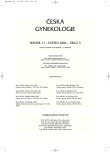Velocimetry of the Ductus Venosus in the First Stage of Labor
Cirkulácia v ductus venosus počas prvej doby pôrodnej
Ciele štúdie:
Určiť možnosť detekcie cirkulačnej variability v ductus venosus pomocou dopplerovskej prietokometrie počas prvej doby pôrodnej mimo kontrakčnej aktivity uteru.
Metodika:
Prospektívna prierezová štúdia zahrňujúca 23 zdravých tehotných žien s fyziologickým priebehom gravidity. Maximálna prietoková rýchlosť počas komorovej systoly (S) a kontrakcie predsiení (A) bola registrovaná z prietokovej krivky ductus venosus v období mimo kontrakčnej activity uteru. Venózny index pulzatility (DV PIV) a index rezistencie (DVI) boli takisto vyhodnotené.
Názov a sídlo pracoviska:
Gynekologicko-pôrodnícka klinika, Jesseniova lekárska fakulta, Univerzita Komenského, Martin.
Výsledky:
Akceptovateľné prietokové krivky k hodnoteniu duktálnej venóznej cirkulácie sme získali u 19 plodov (83 %). Priemerná hodnota (± SD) indexu rezistencie a indexu pulzatility pre ductus venosus bola 0,46 ± 0,07 (95% CI: 0,42-0,49), respektíve 0,57 ± 0,12 (95% CI: 0,51-0,63). Priemerná hodnota (± SD) maximálnej prietokovej rýchlosti počas ventrikulárnej (S) a atriálnej kontrakcie (A) bola 65 ± 8 cm/s respektíve 35 ± 5 cm/s.
Záver:
Vyšetrenie prietokových parametrov v ductus venosus je možné vykonať i počas pôrodu. Naše zistenie prispieva k rozšíreniu možností lepšieho zhodnotenia intrauterinného stavu plodu a dáva podklad k nevyhnutnému určeniu fyziologických referenčných hodnôt pre tieto cirkulačné parametre v budúcnosti.
Kľúčové slová:
ductus venosus, dopplerovská sonografia, pôrod
Authors:
N. Szunyogh; P. Žúbor; S. Galo; J. Višňovský; J. Danko
Authors‘ workplace:
Gynekologicko-pôrodnicka klinika, Jeseniova lekárska fakulta, Univerzita Komenského, Martin
Published in:
Ceska Gynekol 2006; 71(3): 179-183
Category:
Original Article
Overview
Objective:
To assess feasibility and physiological variation of fetal ductus venosus Doppler velocimetry during the first stage of labor between uterine contractions.
Study design:
A prospective cross-sectional study including 23 healthy women with low-risk pregnancies. Maximum velocities during ventricular systole (S) and atrial contraction (A) were recorded in the ductus venosus between contractions. Pulsatility index for veins (DV PIV) and the ductus venosus index (DVI) were also calculated.
Setting:
Department of Obstetrics and Gynecology, Jessenius Faculty of Medicine, Comenius University, Martin.
Results:
Acceptable ductus venosus waveforms were acquired in 19 fetuses (83%). The mean ± SD values of the ductus venosus index and the pulsatility index were 0.46 ± 0.07 (95% CI: 0.42-0.49) and 0.57 ± 0.12 (95% CI: 0.51-0.63), respectively. The mean ± SD values of maximum velocities during ventricular systole (S) and atrial contraction (A) were 65 ± 8 cm/s and 35 ± 5 cm/s, respectively.
Conclusion:
Ductus venosus blood flow velocities can be assessed during labor. This calls for an extension of the detection possibilities of intrauterine fetal status and gives an idea to establish reference ranges for these circulation parameters during labor in the future.
Key words:
ductus venosus, Doppler ultrasound, labor
Labels
Paediatric gynaecology Gynaecology and obstetrics Reproduction medicineArticle was published in
Czech Gynaecology

2006 Issue 3
Most read in this issue
- Discrepancy of Ultrasound Biometric Parameters of the Head (HC - Head Circumference, BPD - Biparietal Diameter) and Femur Length in Relation to Sex of the Fetus and Duration of Pregnancy
- Serum Antibodies against Annexin V and Other Phospholipids in Women with Fertility Failure
- Intrahepatic Cholestasis of Pregnancy – Four Case Reports
- Prevention of Rh (D) Alloimmunization in Rh (D) Negative Women in Pregnancy and after Birth of Rh (D) Positive Infant
